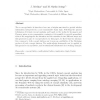446 search results - page 42 / 90 » Formal concept analysis based on hierarchical class analysis |
102
Voted
ISCI
2010
14 years 11 months ago
2010
The t-concept lattice is introduced as a set of triples associated to graded tabular information interpreted in a non-commutative fuzzy logic. Following the general techniques of ...
117
Voted
EPEW
2006
Springer
15 years 4 months ago
2006
Springer
Abstract. As Web service-based system integration recently became the mainstream approach to create composite services, the dependability of such systems becomes more and more cruc...
144
Voted
EMNLP
2010
14 years 10 months ago
2010
In this paper, we develop multilingual supervised latent Dirichlet allocation (MLSLDA), a probabilistic generative model that allows insights gleaned from one language's data...
102
Voted
CAINE
2008
15 years 2 months ago
2008
Data mining became increasingly important in bioinformatics and biomedical area during last decade. Various data mining methods, such as association rule mining and clustering, ha...
115
click to vote
BIBM
2008
IEEE
15 years 7 months ago
2008
IEEE
— Protein sequence motifs information is crucial to the analysis of biologically significant regions. The conserved regions have the potential to determine the role of the protei...


